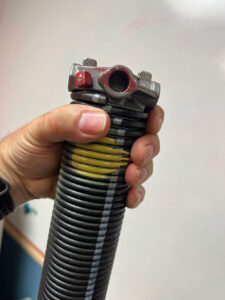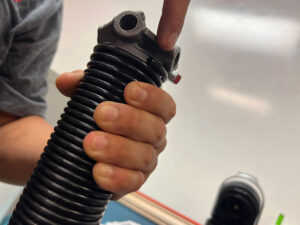Telling the direction in which a garage door torsion spring is wound can be vital for safe and effective replacement or repair. Here’s how you can determine whether you have a left-wound or a right-wound spring:
- Location of the Springs:
- In a typical two-spring system, when you are standing inside the garage and looking at the door, the left-wound spring is usually on the right side of the garage door, and the right-wound spring is on the left side of the door.
- Please note that this is not a definitive rule, as some systems might be set up differently, but it is a common configuration.
- Ends of the Spring Coils:
- Stand facing the spring and observe the coils.
- A right-wound spring will have the end of the last coil pointing in the clockwise direction.
- A left-wound spring will have the end of the last coil pointing in the counter-clockwise direction.


- Spring Cones:
- The cones at the ends of the springs are usually color-coded. Typically (but not always):
- Red indicates a right-wound spring, and it is usually located on the left side when you’re facing the garage door from the inside.
- Black indicates a left-wound spring, and it is usually located on the right side when you’re facing the garage door from the inside.
- Please note that these color codes are not universal, so it is important to confirm with the spring’s manufacturer or a professional installer.
- Written Markings:
- Some springs have painted markings or tags that indicate their winding direction. Check for any labels or markings on the spring that might indicate its winding direction.
- Physical Inspection:
- Stand directly in front of the wound spring. If the coils close (get tighter) as you go in a clockwise direction, it is a right-wound spring. If the coils close (get tighter) as you go in a counter-clockwise direction, it is a left-wound spring.
Please proceed with extreme caution when dealing with garage door springs. They are under a significant amount of tension and can cause severe injury if mishandled. If you are not comfortable or experienced with garage door springs, it is best to hire a professional garage door technician to handle the replacement or repair.
Give us a call at (425) 454-3250

